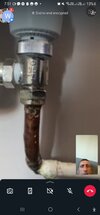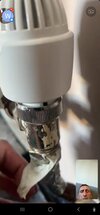1. Normal copper pipes are not threaded. They are generally attached to valves and the like with compression fittings. The valve has an outside threaded bore, the bore being (e.g.) 15 mm. Before the pipe is inserted into the bore, a compression nut is slipped over the pipe followed by an olive. The olive is usually brass or copper being relatively soft metals. The mouth of the bore of the valve, and the back of the compression nut, are chamfered at 45 degrees. When the nut is tightened onto the threaded valve stem, the olive is compressed onto the pipe, and also squashed against the chamfers of both valve and compression nut. This is what makes the water tight seal. It is also what makes adding PTFE tape to the threads pointless.
2. If the joint is leaking it may be for a number of reasons:
2.1 The joint has not been done up tight enough. In this case tightening the nut slightly may stop the leak. However, don't wrench it up too tight or the olive may sink into the copper pipe and actually make the leak worse. See 2.3 below.
2.2 Where old fittings have been re-used, there may be slight gaps where things have moved while dismantled. If so, taking the joint apart (which will allow water out), cleaning the valve, pipe and olive, then wrapping 5 to 10 wraps of PTFE tape around the olive and doing the joint up again may fix it.
2.3 If the old compression fitting was overtightened, it may have forced the olive into the pipe and "waisted" the pipe. The only real cure is to dismantle the joint (water will come out) cut of the damaged piece of copper and solder a new piece in with a coupler then remake the joint with a new olive.
3. Be aware that if going for 2.2 or 2.3 the water will need to be isolated by draining the system, "bunging" the feed and expansion tank (for non-sealed systems), de-pressuring the system (for combi and sealed systems) or freezing flow and return to the radiator. If using freezing, don't attempt to solder within 450 mm / 18 inches of the freeze point.



